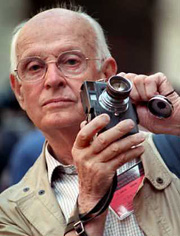|
 |
| Henri Cartier-Bresson, widely regarded as one
of the great photographers of the 20th century, has died aged 95,
LCI television reported on August 4, 2004.
(Reuters) |
Frenchman Henri Cartier-Bresson, one of the great photographers of the
20th century and a founding father of modern photojournalism , has died aged 95,
family friends said Wednesday.
A founder of the Magnum picture
agency in 1947 who admirers dubbed "the eye of the century,"
Cartier-Bresson died in the south of France Monday, LCI television channel
said.
The Web site of newspaper Liberation said the photographer, an
intensely private man, was buried Wednesday in a quiet family ceremony at
Monjustin, in the Provence region.
"France has lost a photographer of genius, a true master, one of the
most gifted artists of his generation and one of the most respected in the
world," said President Jacques Chirac.
"He was the greatest. What he saw was extraordinary," said Sipa Press
founder Goksin Sipahioglu. "He was a great and humble man."
Cartier-Bresson made his name partly by being in the right place at the
right time, plus a talent for capturing in black and white what he called
the "decisive moment."
During his career Cartier-Bresson documented some of the most emblematic moments and figures of
the last century.
From the Spanish Civil war to the liberation of Paris during World War
II, the death of India's Mahatma Gandhi to the fall of Beijing to Mao
Zedong's forces in 1949 or the Berlin Wall.
In 1954, the Frenchman also became the first Western photographer
allowed into the Soviet Union after the death of Soviet dictator Josef
Stalin the previous year.
Cartier-Bresson's most striking photographs, such as the French boy
proudly carrying two huge bottles with a little girl giggling behind him
or the rotund man caught in
mid-leap across a Paris puddle, illustrate the superb design, insight and
gentle good humor characteristic of his work.
One of his most famous photographs, the 1938 "Picnic on the Banks of
the Marne," shows a working-class family enjoying a picnic, innocently
unaware of the camera's presence.
"In photography, you've got to be quick, quick, quick, quick, like an
animal and a prey," Cartier-Bresson said in a rare filmed interview
accompanying a 1979 exhibit of his works.
"And you have to try to put your camera between the skin of a person
and his shirt."
As a young man, Cartier-Bresson wanted to become a painter and studied
in Paris with Cubist Andre Lohte and Jacques Emile Blanche, continuing to
draw and paint throughout his life.
In 1935, he studied film-making in the United States. On his return to
France he collaborated with Jean Renoir, son of the painter Pierre-Auguste
Renoir, in making "La Regle du Jeu" and "Partie de Campagne," two
outstanding pre-war French films.
In 1937, he made the documentary "Victoire de la Vie" on
civil-war Spain, but the outbreak of World War II interrupted his
film-making career. He directed one more documentary in 1944, but then
turned wholeheartedly to still photography.
The son of a rich industrialist, Henri Cartier-Bresson was born in
Chanteloup, near Paris, on Aug. 22, 1908. He began taking pictures with a
simple box camera in the 1930s.
In World War II he spent three years in a German prison camp. He
escaped twice, was caught, and then escaped again. He joined the French
resistance and helped others to escape.
The publication in 1952 of "Images a la Sauvette" ("The Decisive
Moment") marked the height of his technique, although he published many
collections such as "China in Transition," "The People of Moscow,"
"Balinese Dancers" and "The Europeans."
Cartier-Bresson quit Magnum in 1966, but continued to take photographs,
living in Paris with his second wife, photographer Martine Franck, and
their adopted child.
He later abandoned the camera for his other love, drawing. Last year he
set up the Fondation Henri Cartier-Bresson.
(Reuters) | 